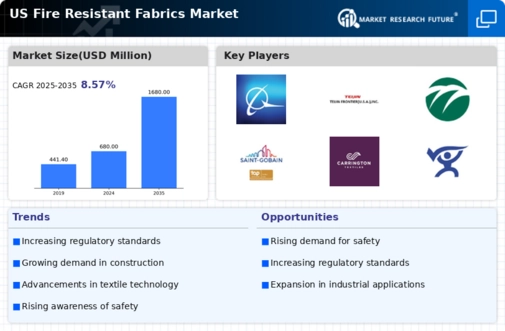The fire resistant fabrics market is characterized by a dynamic competitive landscape, driven by increasing safety regulations and a growing demand for protective clothing across various industries. Key players such as DuPont (US), 3M (US), and Honeywell (US) are at the forefront, leveraging innovation and strategic partnerships to enhance their market positions. DuPont (US) focuses on developing advanced materials that meet stringent safety standards, while 3M (US) emphasizes its commitment to sustainability and product diversification. Honeywell (US) is actively pursuing digital transformation initiatives to optimize its operations and improve customer engagement, collectively shaping a competitive environment that prioritizes innovation and responsiveness to market needs.
In terms of business tactics, companies are increasingly localizing manufacturing to reduce lead times and enhance supply chain resilience. The market structure appears moderately fragmented, with several players vying for market share, yet the influence of major companies remains substantial. This competitive structure fosters an environment where innovation and operational efficiency are critical for success, as smaller firms often struggle to compete against the resources and capabilities of larger entities.
In November 2025, DuPont (US) announced the launch of a new line of flame-resistant fabrics designed specifically for the aerospace industry. This strategic move not only expands DuPont's product offerings but also positions the company to capitalize on the growing demand for specialized protective materials in high-risk sectors. The introduction of these fabrics is expected to enhance safety standards in aviation, thereby reinforcing DuPont's reputation as a leader in innovative solutions.
In October 2025, 3M (US) unveiled a partnership with a leading textile manufacturer to develop eco-friendly fire resistant fabrics. This collaboration underscores 3M's commitment to sustainability, aligning with current market trends that favor environmentally responsible products. By integrating sustainable practices into its manufacturing processes, 3M aims to attract a broader customer base while addressing regulatory pressures regarding environmental impact.
In September 2025, Honeywell (US) launched a digital platform aimed at enhancing the performance and traceability of its fire resistant fabrics. This initiative reflects Honeywell's strategic focus on digitalization, enabling customers to access real-time data on product performance and compliance. Such advancements not only improve customer satisfaction but also position Honeywell as a forward-thinking player in the market, capable of leveraging technology to meet evolving customer needs.
As of December 2025, current trends in the fire resistant fabrics market indicate a strong emphasis on digitalization, sustainability, and the integration of advanced technologies such as AI. Strategic alliances are increasingly shaping the competitive landscape, allowing companies to pool resources and expertise to drive innovation. Looking ahead, it is anticipated that competitive differentiation will evolve, shifting from price-based competition to a focus on technological advancements, product innovation, and supply chain reliability. This transition is likely to redefine market dynamics, compelling companies to adapt and innovate continuously.

















Leave a Comment